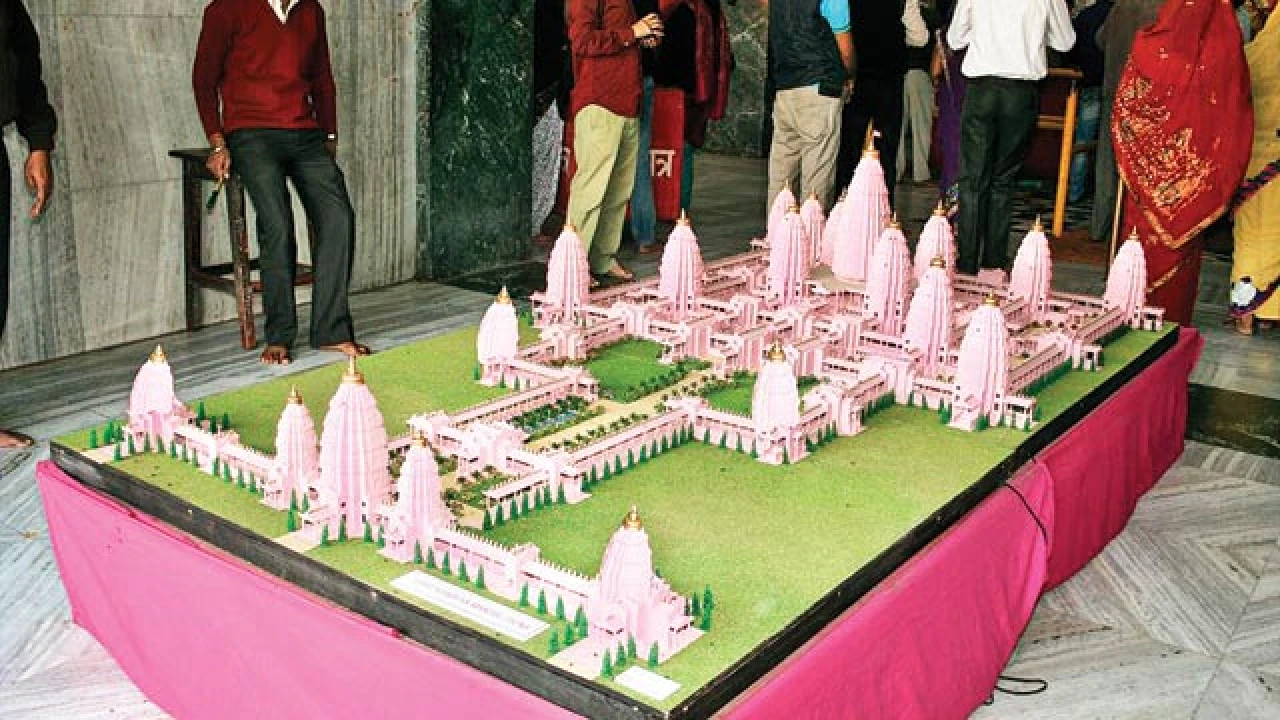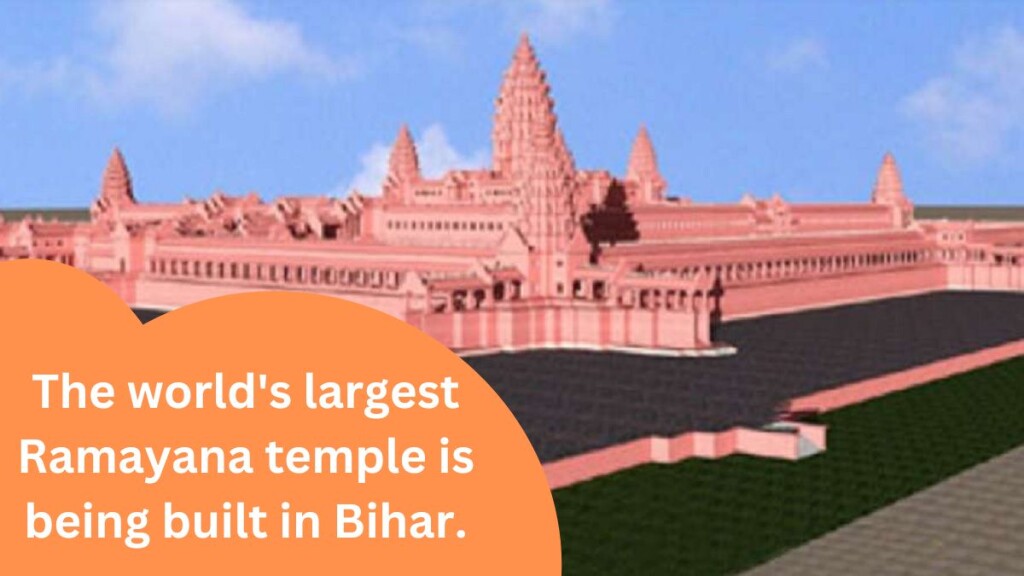Embarking on a monumental journey, the construction of the "world's largest Ramayan temple" in Bihar's East Champaran district commenced on June 20. Spearheaded by the visionary leadership of former Indian Police Service (IPS) officer and Secretary of the Patna-based Mahavir Temple Trust, Acharya Kishor Kunal, along with the esteemed presence of former Chief Justice of the Rajasthan High Court, Justice S. N. Jha, the foundation stone was ceremoniously laid. The initiation of this sacred endeavor was marked by profound religious rituals, setting the tone for a project that transcends mere construction; it embodies a spiritual and cultural legacy. As the groundwork unfolds, the site echoes with the promise of a majestic temple, destined to stand as a testament to faith, tradition, and architectural grandeur in the heart of East Champaran.
The Viraat Ramayan Mandir, a grand Hindu temple complex, envisions an awe-inspiring architectural marvel set against the scenic backdrop of Kaithwalia-Bahuarwa hamlet in the City of Motihari, East Champaran region of Bihar, India. With a staggering estimated budget of ₹500 crore (US$63 million), this ambitious project is poised to become a cultural and spiritual landmark. Designed to transcend conventional expectations, the temple complex is set to feature a sprawling hall capable of accommodating 20,000 people, creating a space for collective worship and community gatherings.
What sets the Viraat Ramayan Mandir apart is its towering height, reaching an impressive 405 feet – nearly twice the stature of the renowned Angkor Wat temple complex in Cambodia. This deliberate choice in dimensions speaks not only to the grandiosity of the project but also to the reverence and homage paid to the rich tapestry of Hindu architecture and heritage.
The inception of the temple's construction, initially slated for June 2015, faced an unexpected delay due to diplomatic intricacies. The Cambodian government's protests to the Indian government played a pivotal role in deferring the commencement of this monumental undertaking. Despite this setback, the Viraat Ramayan Mandir remains a symbol of resilience, poised to bring together devotees and admirers from far and wide once the construction hurdles are overcome.
As the project awaits its green light, the Viraat Ramayan Mandir stands as a testament to the intricate dance between cultural aspirations and diplomatic intricacies. When realized, it promises not only to be a physical manifestation of spiritual devotion but also a testament to the enduring spirit of collaboration that transcends borders in the pursuit of shared cultural legacies. The Viraat Ramayan Mandir is not merely a temple; it is a testament to the undying commitment to preserving and celebrating the rich tapestry of Hindu heritage for generations to come.
What are the preparations regarding this temple?
The Angkor Wat Temple in Cambodia, the Rameswaram Ramanathasvami Temple, and the Madurai Meenakshi Sundaresvara Temple in India served as inspiration for the construction of this temple. The main Hindu deities, Rama and Sita, will have eighteen shrines within the temple.Acharya Kishore Kunal is leading the plan.
The genesis of the monumental project that is the Virat Ramayan Mandir reflects a journey marked by cultural aspirations and diplomatic considerations. Originating as the visionary proposal of the Mahavir Mandir Trust, based in Patna, the initial concept envisioned the temple as the Viraat Angkor Wat Ram Mandir in Hajipur, the twin city of Patna. However, as the project gained momentum, a pivotal decision was made to relocate from Hajipur to the expansive 161 acres acquired in the East Champaran district.
The narrative took an intriguing turn in August 2012 when the Indian government, responding to concerns raised by the Cambodian government, urged the Mahavir Mandir Trust to refrain from constructing an exact replica of the renowned Angkor Wat. In a diplomatic gesture, the temple project underwent a transformation, shedding its initial nomenclature to emerge as the Virat Ramayan Mandir.
This alteration in name and design was not merely a concession to international sensitivities but a testament to the adaptability and resilience of the temple trust. The Virat Ramayan Mandir, in its evolved form, represents a harmonious blend of cultural reverence and diplomatic prudence. The decision to replace the ambitious Angkor Wat replication with a unique structure underscores the temple trust's commitment to cultural diversity and respect for global sentiments.
The unveiling of the temple's model by Bihar Chief Minister Nitish Kumar on November 13, 2013, marked a significant milestone in the project's journey. It symbolized not only the tangible manifestation of architectural plans but also a momentous step towards realizing a cultural landmark that transcends geographical boundaries. The Virat Ramayan Mandir stands as a living testament to the collaborative spirit between cultural aspirations and diplomatic considerations, embodying the rich tapestry of India's cultural heritage.

Materials Used
In the intricate tapestry of the Ram Temple's construction, the incorporation of 250 tons of Mahabalipuram granite adds a layer of historical significance and artistic grandeur. This revered material, sourced from the ancient town of Mahabalipuram, not only symbolizes the enduring strength and timeless beauty associated with granite but also pays homage to the rich cultural heritage of India. The skilled artisans, entrusted with this sacred task, will meticulously carve out a Shivling – a profound representation of Lord Shiva's divine presence. Beyond this, the artisans will embark on a rare and momentous endeavor, crafting a Sahastra Shivling, a structure consisting of a thousand lingams. This ambitious feat carries a profound cultural resonance, harking back to a tradition not witnessed in the country since the 8th century. As the granite takes shape under the hands of these craftsmen, it not only becomes an integral part of the temple's physical structure but also weaves a narrative of artistic revival and spiritual continuity that transcends centuries.
construction of the biggest Shivalinga in the world by 2025 The festival of Mahashivratri
In the sacred endeavor to construct the Virat Ramayana Temple, Acharya Kishore Kunal has unveiled ambitious plans that promise to elevate this spiritual haven to unprecedented heights. The temple, a magnificent three-storeyed structure, will stand as a testament to the grandeur of India's cultural and religious heritage. The focal point of this divine sanctuary will be a colossal Shivalinga, meticulously crafted from black granite rock, weighing an astonishing 200 tonnes. This majestic creation is set to soar to a height of 33 feet, its roundness mirroring the symbolism of completeness and eternity.
Drawing inspiration from the rich tapestry of Indian mythology, the Virat Ramayana Temple will house not just the central Shivalinga but also a Sahasralingam, an awe-inspiring spectacle carved from a massive 250-tonne black granite rock. Significantly, this feat of artistry in Mahabalipuram near Chennai is a revival of a tradition that hasn't been witnessed in India since the eighth century – a renaissance of craftsmanship and devotion.









